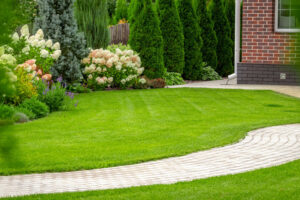Plants can create living privacy screens to reduce noise, block wind, hide a fence line, cover an undesirable view or shield your yard from outside view. They can be used to create a property border or to separate and delineate patios and outdoor living areas. Privacy screens are also useful to hide less attractive things in your yard, such as HVAC units from view.
The key to creating a resilient and attractive privacy screen is to use a variety of different plantings. There are many plants to choose from, including evergreen and deciduous varieties, and they each grow to different heights and widths to help you create perfect, customized living barriers.
Planning Your Privacy Screens for Resilience and Functionality

When choosing your plants, start with defining the function of the privacy screen. If you need a tall privacy screen along a border for a large area, consider fast growing, taller trees such as Leyland Cypress and Green Giant Arborvitae. If your privacy screen only needs to be a medium height when grown, plants such as Skip Laurel and Emerald Green Arborvitae will be a great choice for your needs. Evergreens like Steeds Holly or Sky Pencil Holly are excellent options for hiding or bordering smaller areas such as your view of HVAC units, pool filters, compost, or wood piles.
Planting a variety of plants increases the resilience of your privacy screen, especially with climate change and weather extremes increasingly affecting Maryland. Some plants are intolerant of weather extremes and planting only one type of plant increases the odds of losing the entire privacy screen.
Choosing native plants and avoiding invasive species, such as bamboo, is also recommended. White Pines or American Greenleaf Hollies are two great options.
Mixing Privacy Plants for Structural Diversity and Year-Round Beauty
Multiple rows and layers of different plantings will increase privacy and noise reduction while supporting biodiversity and enhancing beauty. This practice is known as structural diversity.
For increased structural diversity, plant a variety of shrubs, ground covers, trees, and ornamental grasses. Layering by size, such as larger plants behind smaller ones, and adding accents such as ground covers and ornamental grasses, keeps the privacy screen interesting, organized, and tidy looking.
Privacy screens with structural diversity naturally support wildlife, including beneficial insects that provide pest control and pollination. Studies indicate that privacy screens with structural diversity are also less prone to invasive pests.
Planting a variety of privacy plants will also enhance your screen’s visual appeal all year long. For instance, evergreens will provide a beautiful privacy screen year-round, while flowering shrubs, such as viburnums and hydrangeas, will add color for most of the year before dropping their leaves in the fall. A combination of both evergreen varieties and flowering shrubs will provide beauty and functionality throughout the year and allow you to enjoy the peace and quiet of your space!
